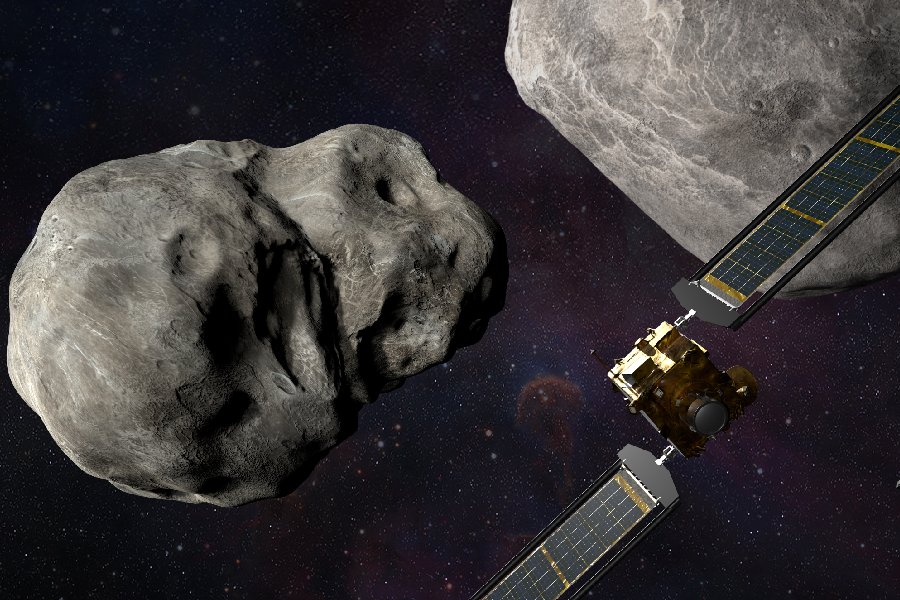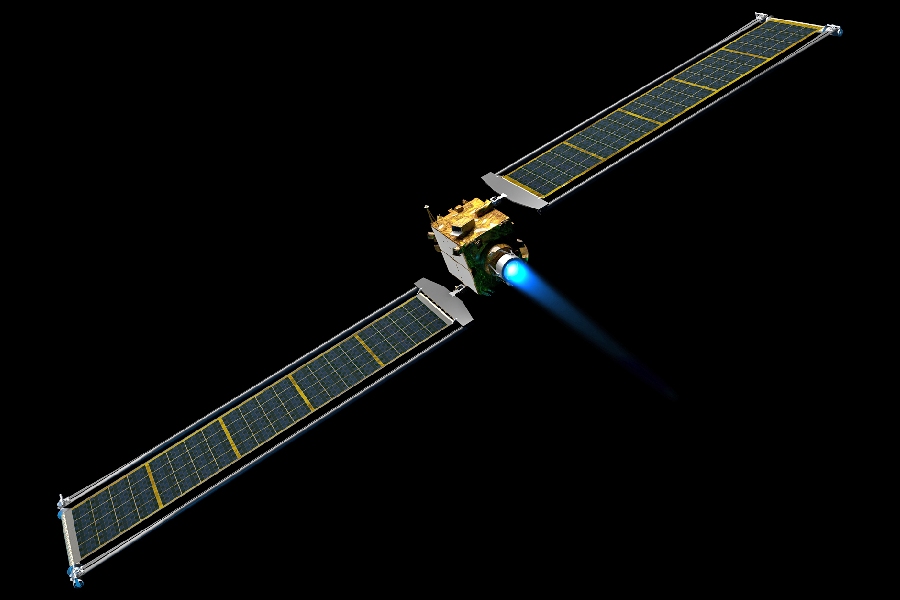As the first-ever mission to demonstrate asteroid deflection technology, the NASA DART Mission represents an exciting step forward in planetary defense against threatening space rocks. So, what is DART NASA?
This article will provide an in-depth analysis of DART’s goals, spacecraft design, target asteroid system, and potential implications. We will examine key aspects of the mission, including the launch, challenging navigation to the target asteroid, asteroid impact, and resulting changes to the orbit.

NASA DART Mission
The NASA DART (Double Asteroid Redirection Test) mission is a planetary defense demonstration. It is designed to test the capability of redirecting the motion of an asteroid in space.
The primary objective is to assess and develop technologies that could alter the trajectory of a potentially hazardous asteroid on a collision course with Earth. DART’s target is the binary asteroid system Didymos, with its moonlet Dimorphous.
Moreover, the spacecraft has a kinetic impactor designed to collide with Dimorphic and change its orbital velocity. This mission aims to enhance our understanding of asteroid deflection techniques for planetary defense.
History of Asteroid Deflection Techniques
Asteroid deflection techniques have been explored theoretically for decades. They represent a potential method to protect Earth from hazardous space rocks on a collision course with our planet.
The concept of altering an asteroid’s orbit has been studied since the 1960s. Early proposals included nuclear explosions, kinetic impactors, gravity tractors, and asteroids dragged by mass drivers. Various organizations, including NASA, ESA, international committees, and space science groups, have conducted detailed analyses and proposals.
So, developing viable asteroid deflection capabilities has become increasingly important as surveys reveal thousands of near-Earth asteroids. A deflection technique could be essential if an imminent impact threat is discovered with enough warning time.
Kinetic Impactor Technique
The kinetic impactor technique uses a high-speed spacecraft to collide with an asteroid. DART demonstrated this method. The spacecraft deliberately crashed into the asteroid at high velocity. The kinetic energy transferred momentum, deflecting the asteroid into a slightly different orbit.
DART struck its target at 6 km/s or 13,000 mph. This technique shifted the asteroid’s trajectory gradually over time. Done far enough in advance, even a small nudge could deflect an asteroid enough to miss Earth. DART showed kinetic impactors were viable for planetary defense.
They had advantages like no explosives needed and rapid response capability if an asteroid threat arose with some warning. DART aimed to improve predicting the precise deflection from a kinetic impact.
Autonomous Navigation Software
The DART spacecraft relied on autonomous navigation software for its ambitious mission. This enabled precise directing of the impact with the asteroid.
In the final hours, DART navigated itself using SMART Nav. This allowed real-time course corrections and targeting without human intervention. SMART Nav guided the spacecraft toward images of the asteroid taken by the onboard DRACO imager. This ensured a direct bullseye collision despite the extremely small target asteroid.
Hence, autonomous software was critical for DART’s success. It enhanced precision and effectiveness beyond what human control could achieve over the vast distances involved. This technology paved the way for future applications in asteroid deflection.

International Partnerships
International collaboration for DART Mission
The DART mission represents collaboration between NASA and space agencies worldwide. This global effort advances planetary defense capabilities. NASA leads DART, but key contributions come from the Italian Space Agency, their LICIACube co-passenger satellite, and the ESA-NASA Hera mission.
Shared objectives
International involvement emphasizes this as a global endeavor. Uniting in the shared goal of characterizing asteroid impact and developing deflection skills is crucial.
Collaborative missions like DART leverage expertise worldwide to collect the maximum data possible. Moreover, partnerships expand our knowledge and preparedness on an issue facing all humanity.
So, continued international teamwork will be integral as we translate successes like DART into robust asteroid deflection programs for protecting planet Earth.
Technical Specifications of the Mission
Target asteroids
DART’s ambitious asteroid deflection test requires precision technical specifications and components. The target is the binary asteroid system of Didymos and its moonlet Dimorphos. DART will impact Dimorphous, which has a 160-meter diameter.
Navigation and maneuvering
Autonomous SMART Nav guides DART using images from the onboard DRACO imager and sophisticated algorithms. Also, thrusters steer the spacecraft.
The SMART Nav system provides vital guidance, navigation and control. It processes live image data of the target asteroid and calculates trajectory adjustments for precision targeting. This enables completely autonomous operation without human intervention.
Propulsion system
DART’s propulsion system includes:
- Hydrazine-fueled thrusters
- A NEXT-C ion engine for fine trajectory adjustments
- Tanks holding roughly 500 kg of propellant
So, the spacecraft’s dual-mode propulsion system serves different functions. The hydrazine thrusters provide large direction changes for the initial aim towards Didymos.
Moreover, the ion engine makes delicate fine-tune-targeting corrections over long distances. This dual approach allows balancing sufficient impulse while conserving fuel.
Impact parameters
Technical factors like the 6 km/s impact velocity, roughly 1,280 pounds (580 kilograms) spacecraft mass, targeting accuracy, and engine performance are vital. These factors are necessary to demonstrate measurable deflection.
Key impact parameters were precisely defined to ensure optimal energy transfer between DART and Dimorphous. Factors like hitting the moonlet head-on, the spacecraft’s size, high speed, and mass deliver the required impulse for deflection. However, nuclear devices were avoided to leave no lasting radiation.
Conclusion
In this exploration, we have aimed to illustrate the groundbreaking nature of NASA’s DART mission. As the first demonstration of asteroid deflection technology, DART marks a major milestone in our ability to protect Earth from potential asteroid collisions.
By successfully impacting its target, the NASA DART mission will reveal new insights into kinetic deflection techniques while setting the stage for continued progress in planetary defense.
This innovative mission highlights the best of scientific ingenuity, precision spacecraft engineering, and international collaboration. As DART paves the way for future asteroid deflection testing and implementation, we look forward to a safer future in space thanks to missions like this expanding humanity’s cosmic capability and resilience.
